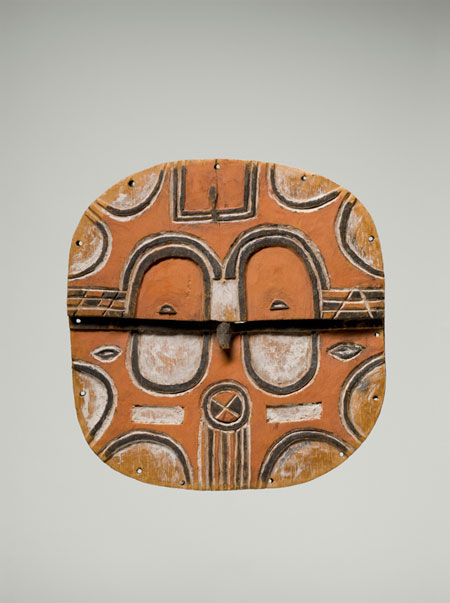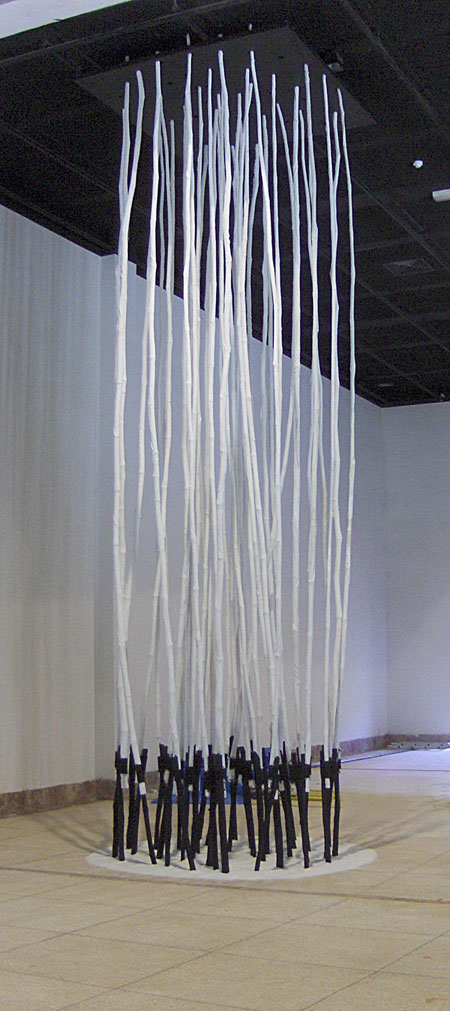|

The underground can seem never ending. For, as far as one digs, there is still farther to go. This sense of the limitless has inspired a complex network of artworks that address concepts of invisibility and the divine, and as mining and other extractive practices afforded new visions of the underground, ideas of memory and loss.
Masks, figures, musical instruments, prints, photographs, and film provide insight into the ways artists have grappled with how to create a vision of unseen or unknowable forces, how to imagine the border between the living and dead, how to present the history hidden beneath our feet, and how to address the gains and losses of drilling beneath the earth's surface. Creatures that can move or tunnel between the underground and surface, such as spiders, mudfish, snakes, and dogs, have also inspired a range of artworks across the African continent that suggest just how important the underground has been to the imagination of artists for centuries.
|

Edo artist, Benin kingdom court style, Nigeria
Plaque
Mid-16th to 17th century
Copper alloy
Field Museum, Chicago, #8259
Mudfish on the move. Mudfish live beneath the water in mud but can cross dry land. Their ability to move between mud, water, and air makes them evocative emblems of royal power and ile, the mud in which the world began and to which the ancestors return. Mudfish imagery dates back for centuries. A 16th- to 17th-century plaque with two entangled mudfish was likely once installed in the palace alongside others to suggest the flow of a river. Mudfish also appear on the collar of a hip pendant worn by an 18th- to 19th-century chief or dignitary as part of his formal regalia.
|
Christine Dixie
b. 1966, South Africa
Even in the Long Descent I-V
2007
Etching and mezzotint on paper
National Museum of African Art, purchased with funds provided by the Annie Laurie Aitken Endowment, 2011-6-3.1-5
Buried or forgotten underground. The skylit landscape occupies less than one-fifth of this five-part work because the artist chose to focus on what is hidden in the blood red earth below. Christine Dixie describes how she was inspired while traveling around Grahamstown, South Africa, where she lives. Aware of the violent history of the Xhosa Wars (also known as the Cape Frontier Wars, 1779-1879), she imagined "a family buried far beneath the ground, like a memory that sometimes wants to surface but the weight of the earth presses down."
|

Teke artist, Democratic Republic of the Congo
Kidumu mask
Most likely early 20th century, collected 1929
Wood, pigment
Musée du Quai Branly, Paris, France, 71.1932.89.82
Dividing above and below ground. Divided by a central band to provide a sense of "above" and "below," this mask was collected by French geologist Victor Babet in 1929. Its masquerader would cartwheel to suggest a cyclical relationship between subterranean ancestral realms and the world of the living. Though popular with collectors, such masks are rare. They were made for a limited time , perhaps as a response to the slave trade and introduction of mining.
|

George Osodi
b. 1974, Nigeria
De money series no. 1
2009
Fuji crystal archival print
National Museum of African Art, museum purchase, 2011-16-1
Mining and cutting into the land. Despite the dangers to their health from mercury exposure and damage to the environment from land degradation and water pollution, jobless youths and their families continue to search for gold, or "The Money," in Obuasi, Ghana. Osodi frames aesthetic, alluring, and often shocking images that challenge viewers to consider real and troubling issues from very human perspectives.
|
Yoruba artist, Nigeria
Onile (male figure)
Date unknown
Terracotta
National Museum of African Art, gift of Walt Disney Co., a subsidiary of The Walt Disney Company, 2005-6-73
The material of the underground. Two extraordinary figures that once served as focal points within the meeting lodge of the Ogboni (or Oshugbo) society elders are reunited in this exhibition. To have fired such large scale and detailed figures required exceptional technical skill, and there are no other known terracotta examples. The fact that they are made of clay may allude to the power of the earth in assisting society members as they make important judiciary decisions and balance the power of the king. The snake, a creature that can slither above and below ground, at the basis of the female figure reinforces its association with ideas of the underground.
|

Hassan Echair
b. 1964, Morocco
Ascension
2006
Bamboo, charcoal, paint
Site-specific installation, National Museum of African Art, Smithsonian Institution
Connecting the underground and heaven. Hassan Echair works with combinations of stone, wood, and cord to explore the tensions between the gravity of the earth and the vertical flight of esprit (the spirit or mind). As he says, "between the horizontal and the vertical, there is equilibrium. One seeks this equilibrium." He envisions an underground-on which the living walk and in which the dead are buried-that is held in balance with the upward trajectory of the soul.
|
|
|





